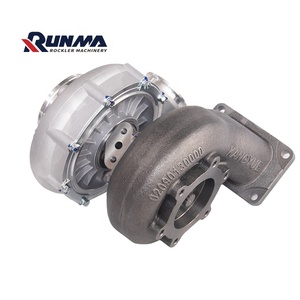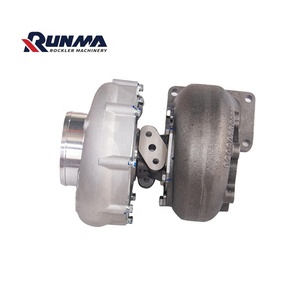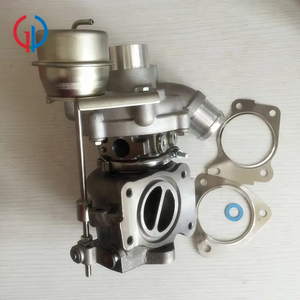Types of Small Turbochargers
A small turbocharger is a forced induction component that uses an exhaust gas turbine to spin a compressor, drawing in more air, compressing it, and pushing it into the engine's intake. This creates a denser air charge that allows for more fuel injection into the combustion chamber, resulting in increased power. Small turbochargers are particularly popular in compact car engines as they enable vehicles to generate more power without the weight and expense of larger engines.
Showing relative power output, lag reduction, and efficiency across RPM ranges
Small Twin-Scroll Turbocharger
The small twin-scroll turbocharger houses both turbine and compressor in the same casing as a single-scroll design, but with a crucial difference: the turbine side features two separate scroll channels. These channels direct exhaust pulses from different cylinders separately – typically, the first and fourth cylinders feed one scroll, while the second and third cylinders feed the other.
Key benefits: Enhanced pulse harnessing, quicker spool-up time, broader power band, improved low-end torque
Variable Geometry Turbocharger (VGT)
The VGT features adjustable vanes that can change their angle of attack to optimize the amount of compressed air delivered to the engine intake. This adaptability allows the turbocharger to perform efficiently across a much wider RPM range, resulting in more consistent power delivery and torque.
Key benefits: Virtually eliminated turbo lag, improved throttle response, greater efficiency at all engine speeds, particularly popular in diesel applications
Variable Twin-Scroll Turbocharger
This advanced turbocharger combines the benefits of both twin-scroll and variable geometry technologies. Its complex design incorporates a single turbine housing with three major components: a variable geometry mechanism, twin-scroll turbine housing, and a wastegate bypass channel. One scroll connects to the wastegate bypass, while the other houses the variable geometry mechanism.
Key benefits: Superior efficiency, minimal turbo lag, exceptional throttle response, optimized performance across all RPM ranges
| Turbocharger Type | Best Application | Lag Reduction | Complexity | Cost |
|---|---|---|---|---|
| Twin-Scroll | Performance gasoline engines | Good | Moderate | Moderate |
| Variable Geometry (VGT) | Diesel engines, high-performance applications | Excellent | High | High |
| Variable Twin-Scroll | Premium performance vehicles | Superior | Very High | Very High |
Specifications of Small Turbochargers
Small turbochargers are engineered with precise specifications that determine their performance characteristics. Understanding these specifications is crucial for selecting the right turbocharger for your specific application.
Compressor Wheel
Small turbochargers typically feature compressor wheels ranging from 30 to 60 mm in diameter. The compressor wheel draws in ambient air, compresses it, and delivers it to the engine's intake system. Smaller wheels spool up quickly but have limited maximum airflow, while larger wheels can deliver more air but require more exhaust energy to spin.
Turbine Wheel
The turbine wheel diameter typically ranges from 40 to 80 mm. Connected to the shaft, this component spins due to exhaust gas energy, driving the compressor wheel. Turbine wheel size directly affects spool-up time and peak power potential. Materials often include Inconel alloys for high-temperature durability.
Trim
Small turbochargers generally have a trim between 40 and 70. Trim represents the ratio of the inducer diameter to the exducer diameter, expressed as a percentage. This specification affects the wheel's pumping characteristics, efficiency curve, and overall performance profile. Lower trim values favor quick response; higher values favor peak power.
AR Ratio
The housing's turbine side aspect ratio (AR) typically ranges from 0.5 to 1.0. This ratio represents the relationship between the cross-sectional area and radius of the turbine housing. Lower AR values promote faster spool-up but restrict high-RPM flow, while higher values do the opposite, affecting boost threshold and overall power delivery.
Boost Pressure
Small turbochargers typically deliver boost pressures ranging from 1.0 to 2.0 bar (14 to 29 psi). This specification indicates how much the compressor pressurizes the incoming air. Higher boost pressures generally yield more power but place greater stress on engine components, requiring appropriate supporting modifications.
Materials
Modern small turbochargers utilize various materials including cast iron housings, stainless steel components, and aluminum compressor wheels. Premium units may feature specialized alloys or ceramic ball bearings. Material selection significantly impacts heat resistance, durability, spool-up characteristics, and overall turbocharger lifespan.
Showing heat resistance, weight, and longevity of common turbocharger materials
Maintenance of Small Turbochargers
Proper maintenance is essential for preserving the performance and extending the lifespan of small turbochargers. Following these maintenance protocols can help prevent costly failures and ensure optimal performance.
-
Regular Oil Changes
Small turbochargers rely heavily on proper lubrication due to their high operating speeds and temperatures. Using high-quality synthetic oil and changing it at recommended intervals (often more frequently than standard engine oil change schedules) ensures adequate lubrication and cooling. Always replace the oil filter during oil changes to prevent contaminants from reaching the turbocharger's bearings.
-
Air Filter Inspection and Replacement
The air filter serves as the first line of defense against debris and contaminants entering the turbocharger. Even small particles can cause compressor wheel damage at the high rotational speeds typical of turbochargers. Inspect the air filter every 5,000-10,000 miles and replace it when it shows signs of clogging or contamination to maintain proper airflow and protection.
-
Intercooler Maintenance
The intercooler cools compressed air before it enters the engine, improving efficiency and power. Regularly inspect intercooler connections for leaks, check the core for debris or damage, and clean as necessary to maintain optimal heat exchange properties. Poor intercooler performance can lead to higher intake temperatures and potential engine damage.
-
Exhaust System Inspection
A properly functioning exhaust system is crucial for turbocharger operation. Regularly inspect all components from the exhaust manifold to the tailpipe for leaks, cracks, or restrictions. Check exhaust gaskets and fasteners for proper sealing and tightness. Exhaust leaks before the turbocharger can significantly reduce performance and cause uneven turbine wear.
-
Professional Inspection and Service
Schedule regular professional inspections every 30,000-50,000 miles or as recommended by the manufacturer. Trained technicians can detect early signs of wear, check wastegate and actuator function, assess shaft play, and perform specialized diagnostics that may not be apparent during routine maintenance. Professional service can identify issues before they lead to catastrophic failure.
How to Choose Small Turbochargers
Selecting the ideal small turbocharger for your application requires careful consideration of multiple factors to achieve the desired performance, reliability, and drivability. Follow this comprehensive selection guide to make an informed decision.
Engine Compatibility
The engine's displacement and configuration are primary considerations when selecting a turbocharger. Larger displacements produce more exhaust gases and typically require larger turbochargers. Different engine configurations (inline, V-type, boxer) may benefit from specific turbocharger designs or arrangements.
Rule of thumb: For every liter of displacement, allow approximately 10-15 PSI of boost pressure for moderate performance gains.
Performance Targets
Clearly define your power goals and intended use case. Are you seeking improved fuel economy with modest power gains, or maximum performance for competition? Your specific targets will significantly influence turbocharger selection, with higher power goals typically requiring larger turbos with appropriate supporting modifications.
Consideration: Higher power outputs generate more heat and stress on engine components, requiring upgraded cooling systems and internal engine components.
| Selection Factor | Importance | Considerations |
|---|---|---|
| Compressor & Turbine Size | Critical | Must be matched to engine displacement and flow requirements; smaller sizes for quicker response, larger for maximum power |
| Boost Pressure | High | Determine target boost level based on engine internals, fuel system, and performance goals |
| A/R Ratio | High | Lower ratios (0.5-0.6) for quick spool and low-end torque; higher ratios (0.7-1.0) for peak power |
| Quality & Reliability | Critical | Choose reputable manufacturers with proven track records; consider bearing type and materials |
| Budget | Practical | Include costs for all supporting modifications; balance initial cost against long-term reliability |
Decision tree for matching turbocharger specifications to application requirements
DIY Small Turbocharger Installation & Replacement
While professional installation is recommended for turbocharger systems, experienced DIY mechanics can successfully replace or install small turbochargers with proper preparation, tools, and technical knowledge. Follow this guide for a systematic approach to the process.
Before beginning the physical work, gather all necessary tools including socket sets, wrenches, pliers, torque wrench, and safety equipment. Acquire the new turbocharger, gasket kit, oil lines, and any additional components required for your specific installation. Review the factory service manual or detailed installation instructions for your vehicle model.
Disconnect the battery and allow the engine to cool completely. Drain the engine oil and, if necessary, the coolant. Properly document and label all connections, hoses, and wiring before removal to ensure correct reassembly. Take photos from multiple angles as additional reference points.
Carefully disconnect and remove intake and exhaust components, heat shields, oil and coolant lines connected to the turbocharger. Disconnect the wastegate actuator and any sensors. Remove the mounting bolts securing the turbocharger to the exhaust manifold and downpipe. Be prepared for significant effort as these fasteners may be heavily corroded or seized.
Thoroughly clean all mating surfaces, removing old gasket material and carbon deposits. Inspect oil feed and return lines for signs of clogging or damage and replace if necessary. Check the exhaust manifold for cracks or warping that could affect turbocharger performance or longevity.
Pre-lubricate the new turbocharger's bearings by adding clean engine oil to the oil inlet. Install new gaskets at all connection points. Carefully position the new turbocharger and hand-thread all bolts before final tightening. Torque all fasteners to manufacturer specifications in the correct sequence. Reconnect all oil and coolant lines, ensuring proper routing and clearance from hot components.
Reinstall all intake and exhaust components, heat shields, and connect any sensors or actuators. Double-check all connections for proper fit and security. Replace the oil filter and refill the engine with the recommended oil type and quantity. If drained, refill the cooling system according to manufacturer specifications.
Reconnect the battery and prime the oil system before starting (if possible). Start the engine and let it idle while checking for leaks or unusual noises. Allow the engine to fully warm up while monitoring oil pressure and temperature. Inspect all connections again for leaks. Take the vehicle for a gentle test drive, gradually increasing load and RPM as you confirm proper operation.
Frequently Asked Questions
No, small turbochargers are widely implemented in both gasoline and diesel engines. In diesel applications, turbochargers are particularly valuable for enhancing combustion efficiency, improving throttle response, and reducing the characteristic turbo lag often associated with larger units. The compact size and quick spool-up characteristics of small turbochargers make them ideal for modern diesel engines where smooth power delivery and emissions compliance are critical concerns.
Yes, naturally aspirated engines can be retrofitted with small turbochargers through a process known as turbocharging conversion. This modification can significantly enhance power output and efficiency when properly implemented. However, such conversions require careful planning and often necessitate additional modifications including fuel system upgrades, ECU tuning, intercooling, and potentially internal engine reinforcements depending on power goals. For optimal results, the turbocharger must be correctly sized for the engine's displacement and intended use case.
Turbo lag refers to the delay between throttle application and the delivery of increased power, caused by the time required for the turbocharger to reach optimal rotational speed (spool up). Small turbochargers reduce this lag through several inherent advantages:
- Lower rotational inertia due to smaller, lighter turbine and compressor wheels
- Less exhaust energy required to accelerate the smaller turbine wheel
- Improved low-end efficiency at the expense of some top-end power
- More responsive wastegate and bypass valve operation
Advanced designs like twin-scroll and variable geometry turbochargers further minimize lag by optimizing exhaust pulse utilization and adjusting flow characteristics based on engine load and RPM.
While small turbochargers don't necessarily require unique maintenance procedures compared to larger units, they do benefit from rigorous adherence to maintenance schedules and best practices:
- Regular oil changes with high-quality synthetic oils that maintain viscosity at high temperatures
- Proper warm-up and cool-down periods to prevent thermal shock and oil coking
- Regular inspection of intake components to prevent debris ingestion
- Attention to oil feed line condition and cleanliness
- Monitoring boost levels to detect potential issues early
Following the manufacturer's recommended service intervals and procedures is essential for maximizing turbocharger lifespan and maintaining optimal performance.
Yes, small turbochargers have applications in both hybrid electric vehicles (HEVs) and certain performance-oriented electric vehicles, though their role differs from traditional applications. In HEVs, turbochargers help optimize the efficiency and output of the combustion engine component, allowing for smaller displacement and improved fuel economy while maintaining power output. In some cutting-edge EV designs, small turbochargers may be employed in experimental "electric turbocharging" systems to compress air for cooling batteries and motors or to increase the efficiency of regenerative systems. However, their primary application remains in conventional and hybrid powertrains rather than pure electric vehicles.






























































